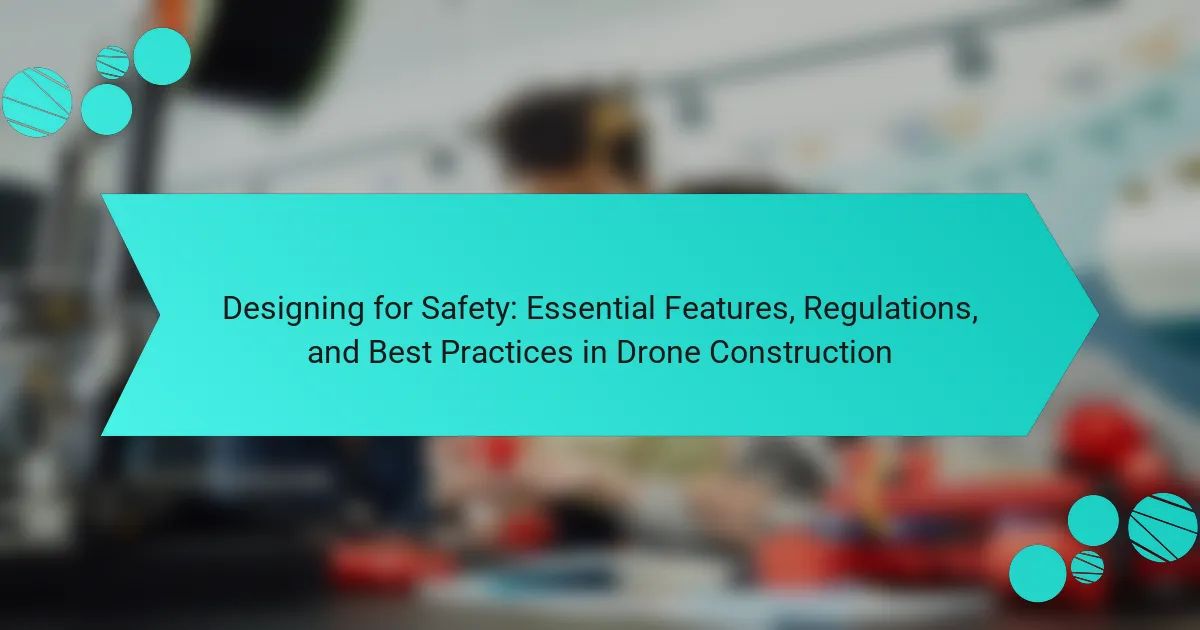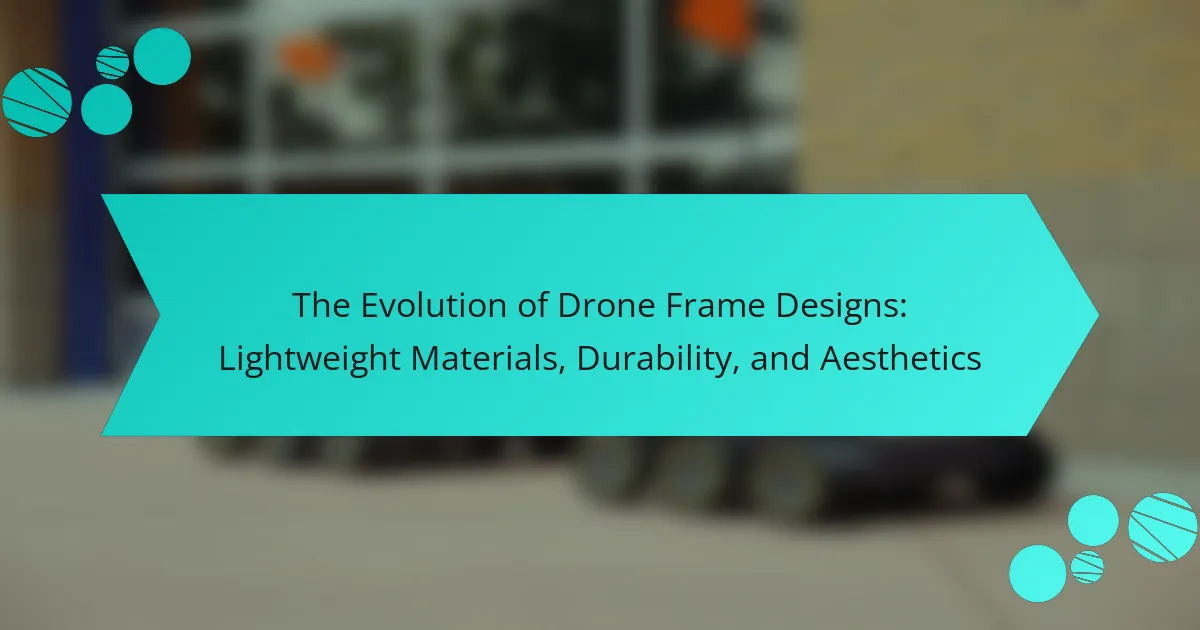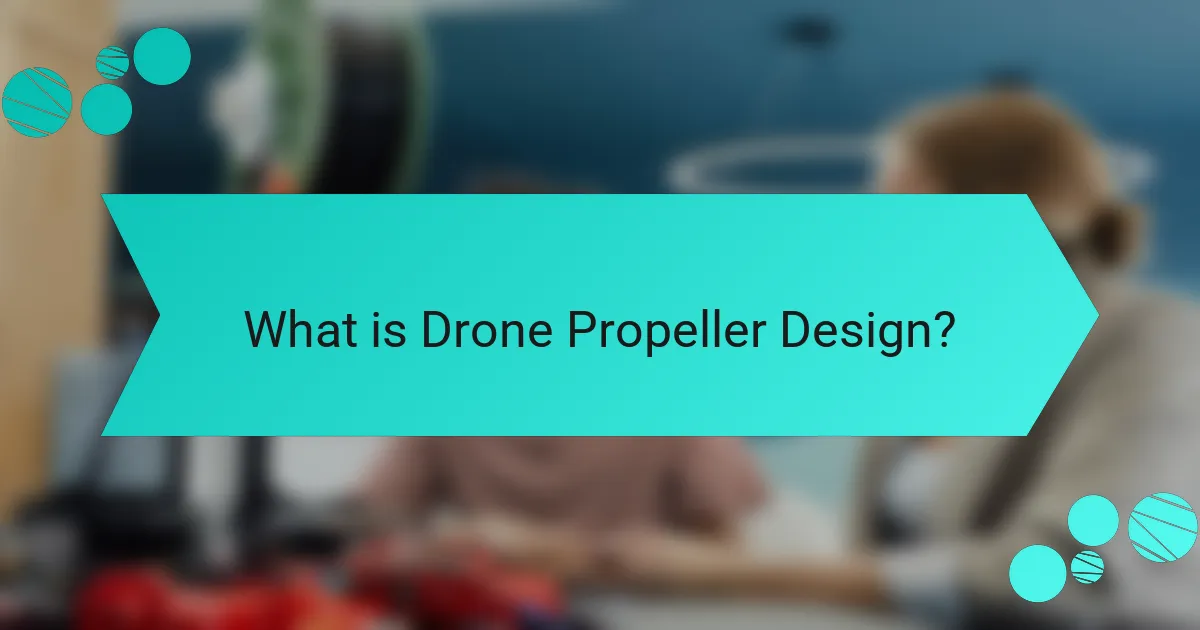
What is Drone Propeller Design?
Drone propeller design refers to the engineering process of creating the rotating blades that enable drones to achieve lift and maneuverability. This design involves selecting the shape, size, and material of the propellers to optimize performance. Factors such as pitch, diameter, and blade number significantly influence the propeller’s efficiency and thrust generation. Advanced computational fluid dynamics (CFD) simulations are often used to analyze airflow around the blades. Proper design can enhance flight stability and reduce energy consumption. Research shows that well-designed propellers can improve a drone’s overall flight time and reduce noise levels during operation.
How does drone propeller design impact flight performance?
Drone propeller design significantly impacts flight performance by influencing thrust, efficiency, and stability. The shape and size of the propeller directly affect the amount of air displaced. Larger propellers generally provide more thrust, enabling better lift. Blade pitch also plays a crucial role; a higher pitch can increase speed but may reduce efficiency at lower speeds. Material choice affects weight and durability, which in turn influences overall flight dynamics. Research indicates that optimizing propeller design can improve energy consumption by up to 20%. This efficiency is vital for longer flight times and better maneuverability.
What are the key factors influencing propeller design?
Key factors influencing propeller design include blade shape, pitch, material, and diameter. Blade shape affects aerodynamics and thrust generation. Pitch determines the angle of attack, influencing speed and efficiency. Material choice impacts weight and durability. Diameter influences the area of thrust and overall performance. Each factor must align with the intended use of the drone for optimal performance.
How do different designs affect lift and thrust?
Different designs of drone propellers significantly affect lift and thrust. Propeller shape influences airflow and pressure distribution. For instance, wider blades generate more lift at lower speeds. Conversely, narrower blades are more efficient at higher speeds, enhancing thrust. Blade pitch also plays a crucial role; a higher pitch increases thrust but may reduce lift. Materials used in propeller construction impact weight and durability, affecting overall performance. Research indicates that optimal blade design can improve efficiency by up to 20%. Therefore, understanding these design elements is essential for maximizing drone performance.
What are the main types of drone propellers?
The main types of drone propellers are fixed-pitch, variable-pitch, and folding propellers. Fixed-pitch propellers have blades that are set at a specific angle. They are simple and cost-effective. Variable-pitch propellers allow for angle adjustment during flight. This feature enhances efficiency and performance. Folding propellers can be folded when not in use. They save space and protect blades during transport. Each type serves different operational needs and flight conditions.
What distinguishes fixed-pitch propellers from variable-pitch propellers?
Fixed-pitch propellers have blades set at a constant angle, while variable-pitch propellers allow for adjustable blade angles. Fixed-pitch propellers are simpler in design and typically lighter. They provide consistent performance but are less efficient across varying flight conditions. Variable-pitch propellers optimize performance by changing pitch to adapt to different speeds and loads. This adaptability enhances efficiency and control in various flight scenarios. Fixed-pitch propellers are commonly found in smaller drones, while variable-pitch models are used in larger, more complex systems. The ability to adjust pitch in variable-pitch propellers can lead to improved thrust and fuel efficiency.
How do multi-blade propellers compare to two-blade propellers?
Multi-blade propellers generally offer higher efficiency and better thrust compared to two-blade propellers. Multi-blade designs can provide smoother airflow and reduce turbulence. This results in improved lift and overall performance, especially in larger drones. Two-blade propellers are simpler and lighter, which can be advantageous for smaller drones. However, they often produce more noise and less thrust at lower RPMs. Multi-blade propellers also tend to operate at lower RPMs while maintaining thrust, which can enhance battery life. Studies show that multi-blade configurations can increase efficiency by up to 20% in certain applications.
Why is efficiency important in drone propeller design?
Efficiency is crucial in drone propeller design because it directly impacts flight performance and battery life. High efficiency reduces energy consumption, allowing drones to fly longer distances. This is essential for applications like aerial photography or delivery services, where extended flight time is valuable. Additionally, efficient propellers produce less noise, which is important for urban operations. Research indicates that optimizing propeller shape can improve efficiency by up to 30%. Enhanced efficiency also contributes to better payload capacity, enabling drones to carry heavier loads without sacrificing performance.
How is propeller efficiency measured?
Propeller efficiency is measured using the thrust produced relative to the power consumed. This is often expressed as a ratio known as the thrust-to-power ratio. The efficiency can be calculated by dividing the thrust by the power input. The power input is typically measured in watts, while thrust is measured in newtons.
Efficiency values are often presented as a percentage. For example, an efficiency of 80% means that 80% of the input power is converted into useful thrust. This measurement can be affected by various factors, including blade design, pitch, and operating conditions.
In practical applications, testing can be conducted in wind tunnels or using thrust stands to gather accurate data. These methods allow for precise calculations of propeller performance under controlled conditions.
What design elements contribute to improved efficiency?
Aerodynamic shape contributes to improved efficiency in drone propeller design. A well-designed propeller minimizes drag and maximizes thrust. Blade pitch is another crucial element. It affects the angle at which air interacts with the blades. Optimizing blade pitch enhances lift and reduces energy loss. Material selection also plays a significant role. Lightweight materials decrease overall weight, improving efficiency. Additionally, the number of blades impacts performance. Fewer blades can reduce drag, while more blades increase thrust. Finally, blade length influences efficiency. Longer blades can capture more air, enhancing propulsion. Each of these design elements works together to improve overall efficiency in drone operation.
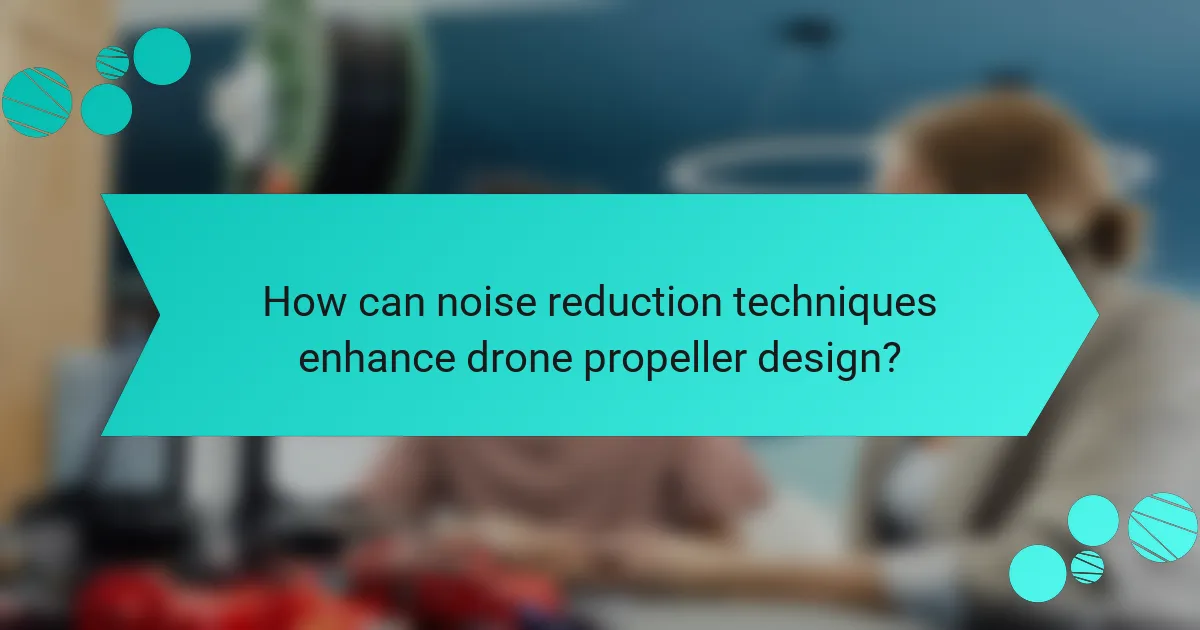
How can noise reduction techniques enhance drone propeller design?
Noise reduction techniques can enhance drone propeller design by minimizing sound emissions during operation. These techniques include optimizing blade shape and material selection. Improved aerodynamics can reduce turbulence, leading to quieter flight. Additionally, using sound-absorbing materials can further dampen noise levels. Research shows that adjustments in pitch and rotation speed can significantly impact noise output. For instance, a study by H. H. Lee et al. (2020) found that specific propeller designs reduced noise by up to 10 decibels. This reduction can improve user experience and compliance with noise regulations. Overall, effective noise reduction techniques contribute to more efficient and user-friendly drone operation.
What are the common sources of noise in drone propellers?
Common sources of noise in drone propellers include aerodynamic turbulence, blade vortex interactions, and motor vibrations. Aerodynamic turbulence occurs when air flows irregularly around the propeller blades. This irregular flow creates fluctuating pressure, generating noise. Blade vortex interactions happen when the rotating blades create vortices that interact with each other, resulting in sound waves. Motor vibrations contribute to noise as well. These vibrations can stem from imbalances in the motor or propeller assembly. Each of these noise sources can significantly impact the overall sound profile of a drone during operation.
How do blade shape and material affect noise levels?
Blade shape and material significantly affect noise levels in drone propellers. Aerodynamic design influences how air interacts with the blades. For instance, blades with a wider chord and specific shapes can reduce turbulence, leading to lower noise emissions. Materials also play a crucial role; softer materials tend to absorb sound better than harder ones. Research shows that composite materials can minimize noise compared to traditional metals. Additionally, the angle of attack in blade design can enhance or reduce noise levels during operation. Overall, optimizing blade shape and selecting appropriate materials are essential for effective noise reduction in drone propeller design.
What role does propeller speed play in noise generation?
Propeller speed significantly influences noise generation in drones. Higher propeller speeds typically result in increased noise levels due to greater airflow disruption. This disruption creates turbulence, which contributes to sound production. Additionally, faster rotations can lead to the formation of shock waves, especially at speeds approaching or exceeding the speed of sound. Research indicates that noise levels can increase by 3 to 5 decibels with every doubling of propeller speed. Thus, optimizing propeller speed is crucial for reducing operational noise in drone design.
What noise reduction techniques are available for drone propellers?
Noise reduction techniques for drone propellers include blade design optimization, active noise control, and the use of sound-absorbing materials. Blade design optimization involves altering the shape and pitch of the blades to minimize turbulence and noise generation. Active noise control employs microphones and speakers to create sound waves that cancel out the noise produced by the propellers. Sound-absorbing materials can be integrated into the propeller structure to dampen vibrations and reduce noise levels. These methods have been shown to significantly decrease the overall sound emitted by drones during operation.
How does altering blade pitch contribute to noise reduction?
Altering blade pitch contributes to noise reduction by optimizing the angle at which the blades interact with the air. A reduced pitch angle decreases the lift generated by the blades, leading to lower thrust levels. This reduction in thrust subsequently lowers the overall noise produced during operation. Additionally, adjusting the pitch can minimize turbulence around the blades, which is a significant source of noise. Research indicates that an optimal pitch setting can lead to a noise reduction of up to 10 dB in certain drone designs. Thus, precise control of blade pitch is essential for achieving quieter drone performance.
What innovations in materials can help minimize noise?
Innovations in materials that can help minimize noise include advanced composites and acoustic metamaterials. Advanced composites, such as carbon fiber reinforced polymers, reduce weight and improve aerodynamic efficiency. This leads to lower noise generation during flight. Acoustic metamaterials are engineered to control sound waves. They can absorb or redirect noise, significantly decreasing sound levels. Research shows that these materials can achieve sound reduction of up to 30 decibels. Their application in drone propellers enhances performance while minimizing auditory impact.
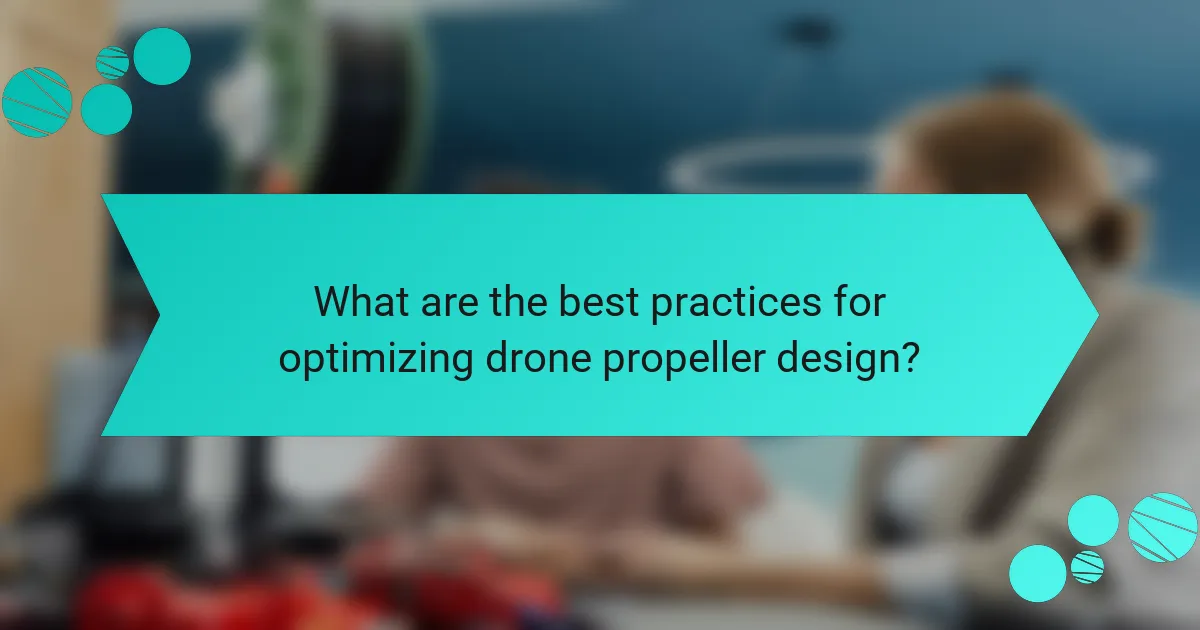
What are the best practices for optimizing drone propeller design?
The best practices for optimizing drone propeller design include selecting the appropriate material, optimizing blade shape, and ensuring proper sizing. Using lightweight materials like carbon fiber increases performance and efficiency. Aerodynamic blade shapes reduce drag and enhance lift. Proper sizing of the propeller relative to the drone’s weight and motor power is crucial for optimal thrust. Additionally, testing different pitch angles can improve flight characteristics. Computational fluid dynamics (CFD) simulations are effective for analyzing performance before physical testing. These practices lead to improved efficiency and reduced noise during operation.
How can drone operators choose the right propellers for their needs?
Drone operators can choose the right propellers by considering size, pitch, and material. The size of the propeller affects lift and efficiency. Larger propellers generate more thrust but may require more power. Pitch refers to the angle of the blades. A higher pitch increases speed but can reduce thrust. Material influences durability and weight. Common materials include plastic and carbon fiber. Operators should also consider the drone’s weight and intended use. For example, racing drones benefit from smaller, high-pitch propellers. In contrast, aerial photography drones often use larger, lower-pitch propellers for stability. Testing different combinations can help determine the best fit for specific needs.
What factors should be considered when selecting propeller size?
Propeller size selection depends on several key factors. These factors include the drone’s weight, intended use, and motor specifications. A heavier drone typically requires larger propellers for adequate lift. The intended use, such as racing or photography, influences the desired speed and stability. Motor specifications, including thrust and RPM, determine the optimal propeller size for performance. Additionally, environmental conditions like altitude and air density can affect propeller efficiency. Choosing the right size ensures balanced flight and optimal battery life.
How can regular maintenance improve propeller performance?
Regular maintenance can significantly improve propeller performance by ensuring optimal functionality and efficiency. It involves routine inspections, cleaning, and repairs to address wear and tear. Regularly checking for damage like dents or cracks helps maintain structural integrity. Clean propellers reduce drag, enhancing thrust and efficiency. Proper alignment ensures balanced rotation, minimizing vibrations. Lubrication of moving parts prevents friction, improving responsiveness. Research indicates that well-maintained propellers can increase flight efficiency by up to 15%. Therefore, consistent maintenance is crucial for maximizing propeller performance and extending its lifespan.
What troubleshooting tips can help with common propeller issues?
Inspect for physical damage on the propeller blades. Cracks or chips can affect performance. Ensure the propellers are securely attached to the motor. Loose propellers can cause vibrations and instability. Check for debris or obstructions around the propeller area. Foreign objects can hinder movement and efficiency. Verify the propeller size and pitch match the drone specifications. Incorrect sizing can lead to reduced thrust. Test the drone in a controlled environment to identify issues. This allows for safe observation of performance. Regular maintenance, including cleaning and periodic checks, can prevent issues. Following these tips can enhance drone performance and longevity.
How can operators identify and fix imbalances in propellers?
Operators can identify and fix imbalances in propellers by performing visual inspections and utilizing balancing tools. Visual inspections reveal any physical deformities or damage on the propellers. Operators should check for chips, cracks, or bends that can cause imbalance. Balancing tools, such as a propeller balancer or a dynamic balancing machine, can help quantify any imbalance. These tools measure the weight distribution and highlight the need for adjustments. Operators can then add or remove material from the propeller blades to achieve balance. Regular maintenance and monitoring are essential to ensure optimal performance and prevent further issues.
What signs indicate that propeller replacement is necessary?
Signs that indicate propeller replacement is necessary include visible damage such as cracks or chips. A propeller that is bent or warped can also affect performance. Excessive vibration during flight often signals an imbalance in the propeller. Decreased flight time or efficiency may indicate wear and tear on the propeller. Unusual noises during operation can also suggest that the propeller is failing. Regular inspection is crucial to identify these issues early. Propellers should be replaced if they show any of these signs to ensure safety and optimal performance.
Drone propeller design is the engineering process that creates the rotating blades essential for drone lift and maneuverability. This article covers the impact of propeller design on flight performance, including factors such as blade shape, pitch, and material choice, which influence thrust and efficiency. It also examines different types of propellers, including fixed-pitch and variable-pitch options, and discusses the importance of efficiency and noise reduction techniques in optimizing design. Additionally, best practices for selecting and maintaining propellers are outlined to enhance overall drone performance and longevity.


